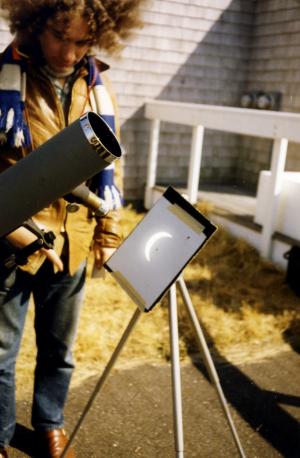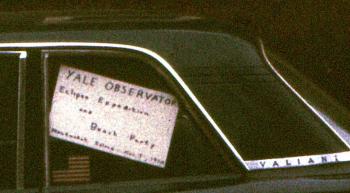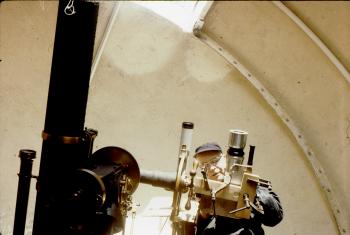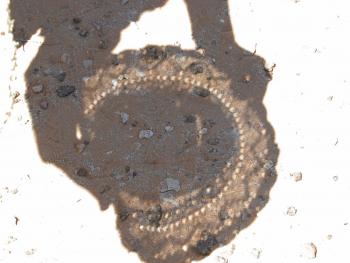 Antiquity: The Greeks used solar and lunar eclipses, as well as the moon’s phases, to determine that the Sun had to be at least thirty times farther away from the earth than the Moon. Since they appeared to be exactly the same size during solar eclipses, that meant the sun was at least thirty times larger than the moon, and evidently larger than the Earth.
Antiquity: The Greeks used solar and lunar eclipses, as well as the moon’s phases, to determine that the Sun had to be at least thirty times farther away from the earth than the Moon. Since they appeared to be exactly the same size during solar eclipses, that meant the sun was at least thirty times larger than the moon, and evidently larger than the Earth.
1000 A.D.: Since antiquity observers must have known that the sun has a large extension of faint light around it - today we call it the solar corona. But the earliest surviving records describing it date from an eclipse seen in Constantinople in 968. By the nineteenth century records from successive eclipses showed that this corona was irregular and changed in shape. Was it the moon’s atmosphere? Or the sun’s?
1868: Indian solar eclipse observed by French and British astronomers detected a bright spectral line never seen before and not in any records from terrestrial laboratories - they call it "Helium" in tune with the Greek word for the sun, "Helios."
1840s – 1919: Vulcan vanishes. After mathematical predictions analyzing Uranus’ anomalous motions led astronomers to discover Neptune in 1846, this set off a feeding frenzy to find more planets. Mercury behaved weirdly, too, so during solar eclipses astronomers searched madly for an inner planet dubbed Vulcan. By the end of the century, continuing expeditions to solar eclipses yielded nothing, which may have been one of the reasons why a young patent clerk named Albert Einstein looked for another reason. The sun's mass might be warping space and time near it, and this would slightly alter Newton's laws and make objects move slightly differently, and also shift slightly in space. At a solar eclipse in 1919, observing from Africa, a British expedition confirmed Einstein's spatial warping by observing stars shifting in position during totality.
Stories abound how a solar eclipse in antiquity ended a war, and how, in the aftermath of the Revolutionary War when a Harvard professor wanted to observe a solar eclipse on the Maine coast (still held by British forces), he was granted access only after John Hancock eloquently appealed to the British and they grumpily relented. There are countless personal stories of travelling to and preparing for a solar eclipse. Any one of us who has made the effort has a story to tell. Some of those stories had consequences. Mine did.

When I was a graduate student in astronomy at Yale University I got involved in the "Yale University Observatory Eclipse Expedition and Beach Party." On March 2, 1970 we all headed to Nantucket Island, most by boat, some by plane, to observe the eclipse from the legendary Maria Mitchell Observatory the next day. Dorrit Hoffleit, the observatory’s director, was also a senior research astronomer at Yale. Dorrit arranged for us to stay at the Ayers’ guest house near the observatory. Some of us organized into teams to take time lapse images of the eclipsing sun, switching to real time at the moment of totality. Others would look for shadow bands, record temperature fluctuations, and listen to the birds. We suggested that faculty might ride bikes or fly kites. The Yale party was well cared for and protected from the expected throngs of onlookers by a contingent of local Boy Scouts. There was also someone responsible for bringing donuts on eclipse day.
 The eclipse day was chilly but crystal clear, and it stayed that way. We set up in the morning, ran drills well before noon, and started taking exposures when the partial phases commenced at 12:30 p.m., taking great care to mark the time of "first contact" by yelling up and down the line. Most watched the partial eclipse phases projected on paper by small telescopes or protective filters. My job was to help get the movie camera ready and operate it during all phases of the event. We mounted it on the counterweight shaft of the venerable 8-inch "Loines Observatory" Clark refractor on Vestal street to use its driving clock to keep the camera and telephoto pointed at the sun automatically. Timing was critical. We all worried that at the moment of totality, at 1:46 p.m., when we had to switch to real time exposures for the next 116 seconds—and, of course, remove the filters that had protected the camera--something, anything, might go wrong. I was the guy on a ladder removing and then replacing the solar filter. In any event, I was high enough above the observing floor that I could see the world outside the dome. At the instant of totality I removed the filter, and Don, the team leader, changed over from time lapse to real time. We all screamed and gasped as a golden twilight spanned the 360 degree horizon darkening to black at the zenith where the corona held forth. I was useless for over a minute, but somehow regained composure enough to replace the filter at the end of totality.
The eclipse day was chilly but crystal clear, and it stayed that way. We set up in the morning, ran drills well before noon, and started taking exposures when the partial phases commenced at 12:30 p.m., taking great care to mark the time of "first contact" by yelling up and down the line. Most watched the partial eclipse phases projected on paper by small telescopes or protective filters. My job was to help get the movie camera ready and operate it during all phases of the event. We mounted it on the counterweight shaft of the venerable 8-inch "Loines Observatory" Clark refractor on Vestal street to use its driving clock to keep the camera and telephoto pointed at the sun automatically. Timing was critical. We all worried that at the moment of totality, at 1:46 p.m., when we had to switch to real time exposures for the next 116 seconds—and, of course, remove the filters that had protected the camera--something, anything, might go wrong. I was the guy on a ladder removing and then replacing the solar filter. In any event, I was high enough above the observing floor that I could see the world outside the dome. At the instant of totality I removed the filter, and Don, the team leader, changed over from time lapse to real time. We all screamed and gasped as a golden twilight spanned the 360 degree horizon darkening to black at the zenith where the corona held forth. I was useless for over a minute, but somehow regained composure enough to replace the filter at the end of totality.
After totality and in the remaining hours of the partial phases, we were all madly happy, closing up shop, eating donuts. There was to be a dinner that evening at the library (I recall it was baked spaghetti). It was a nice party, with grad students, faculty, Boy Scouts, and some locals. A Japanese woman who worked for my thesis advisor was there and we started talking. When the party broke up we walked back to Ayers over the cobblestones and she asked me if I had an alarm clock, because she was taking a very early plane back to Hyannis. I said sure and gave her mine since I would not be in a rush the next day—and it gave me a reason to see her again. We were married soon after! Indeed, solar eclipses can have lasting consequences.
Days later the 16mm film record came out just fine and we presented it at gatherings and parties on campus over the next several weeks, sometimes with live music. Wish I knew where that recording was now.

Related Resources
- The Best-Laid Plans of Mice and Astronomers Often Go Awry: The 1901 Sumatra Eclipse Expedition, The Bigger Picture, Smithsonian Institution Archives
- Science Service, Up Close: Covering Eclipses, Near and Far, The Bigger Picture, Smithsonian Institution Archives
- Well, that sucks…or does it?, O Say Can You See?, National Museum of American History
- Explore the Total Solar Eclipse with the CfA, Harvard-Smithsonian Center for Astrophysics
Produced by the Smithsonian Institution Archives. For copyright questions, please see the Terms of Use.

Leave a Comment